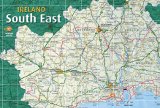South East Ireland Tourism
Travel guide to Ireland's south east
Travel guide to Ireland's south east
Gaeltacht & Galltacht Drive
View Gaeltacht & Galltacht Drive in a larger map
Dungarvan • An Cuinigear • An Rinn • Helvic Head • An Phobal • Ardmore • Whiting Bay • Clashmore • Aglish • Villierstown • Dromana Drive via Cappoquin • Dungarvan •
Gaeltacht is a generic name for areas of Ireland where Irish is spoken as a first tongue. Galltacht refers to the land of the stranger or foreigner. Gall and corruptions of it can be found in Gaultier (see East Waterford Drive), Fingal (Fionn Gall – fair strangers) in Dublin and Dùn na nGall, (the fort of the stranger), which is the present country of Donegal.
Leave Dungarvan on the Cork Road, cross the River Brickey and turn left, signposted An Rinn (Ring). A “Failte” sign welcomes the visitors to the Gaeltacht.
An Cuinigear, signposted left, leads to a sand and shingle beach from which a wonderful 5km peninsula stretches into Dungarvan Bay. A great variety of seabirds can be observed along this narrow stretch of land which offers an enchanting and very scenic walk. Views embrace the full sweep of Dungarvan Bay with the dramatic backdrop of the Comeragh Mountains.
Continue on this narrow road to arrive at the imposing edifice, which is Colaiste na Rinne, an Irish language college which is in operation since 1909. Full term (academic year) and summer courses are run in the language, with summer courses focused on students between the ages of 10-18. The summer courses are combined with all the activities associated with a summer camp and run for three-week periods over June, July and August.
Complete the loop on this narrow road to rejoin the main road, turning left. The sign signals Udaras na Gaeltachta, an organisation set up by the government to attract industries and promote employment in Gaeltacht areas of Ireland.
The warning sign on the road is in Irish – AIRE (care/attention) and PAISTI (children). The sign points towards an oyster bed industry, not open to the public. Follow the sign Ceann Heilbhic (Helvic Head).
Another sign, left, leads to Criostal na Rinne where high quality, individually designed, hand-crafted crystal giftware is produced. Items can be personally inscribed as required. The workshop has a showroom attached. Open all year, 9.00-18.00 Monday to Friday; after hours by appointment.
Continue on this road and rejoin the Helvic Head road. The tiny fishing port of Helvic offers a peaceful stop, where above the pier, an obelisk commemorates those who lost their lives when the ship Erin’s Hope sank off Helvic Head in 1867. The head beyond the village is wild and gloriously scenic.
Return along the road travelled, turning left for An Sean Phobal (The Old Parish) and Aird Mhor (Ardmore).
Continue to Ardmore. Ballyquin Strand East, Ballyquin Strand West and Ardmore East are three beach areas signposted on the approach to Ardmore offering shore fishing for ray, flatfish, bass and dogfish.
Ardmore is a most picturesque village and its neatness has won the national title of Tidy Town Competition. The village boasts a wide range of accommodation and is therefore, a most pleasant place to stay, shop and enjoy the fun in the pubs and the excellent food in the restaurants. Visitors can choose from four lovely beaches.
Park in the village as the main attractions are within easy walking distance.
St. Declan established the first Christian settlement in Ireland at Ardmore in the 5th century. It is not surprising, then, that legends of the saint’s life are very much part of the local folklore just as his monastic site is a local landmark. The monastery grew I eminence, and in the 12th century it was recognised as an Episcopal See. It continued to enjoy its cathedral status well into the 13th century, when it was amalgamated into the diocese of Waterford and Lismore.
Ardmore Round Tower and Cathedral look out over Ardmore Bay in a beautiful elevated position above the village. This is the site of St Declan’s monastery.
Erected by Mael-Ettrim O Duibh-rathra, the church dates from 1203. Parts of an older, possibly 9th century, church from the chancel. Some walls and the east gable date from the 14th century.
The marvellous Romanesque sculptures on the west gable were sculpted between the 9th and 12th centuries. They are arranged in series of arcades and depict scenes from the old and new testaments. Michael the Archangel weighing the souls, Adam and Eve, the judgement of Salomon and the Adoration of the Magi can be identified in this much eroded, but still beautiful, work.
Two Ogham stones are contained within the cathedral for safety. One commemorates Lugaid, son or grandson of Nia-Segmon and the other is dedicated to AMADU (The Loved One). The latter constitutes the longest known Ogham inscription in Ireland.
After the dissolution of the monasteries, the lands were leased to Sir Walter Raleigh in 1591. In 1642, the site was occupied by a small contingent of Royalist troops together with some women and some children. Lord Broghill commanded a superior force of Cromwellian troops with artillery. Upon the surrender of the garrison some 117 out of the 154 survivors were immediately hanged.
The Round Tower, 12th century, is a beautifully proportioned monument to Irish monastic life and is one the finest, if late, examples of this type of structure in Ireland. It rises in three steps to a height of just under 29m. Round Towers were built between the 9th and 12th centuries and were used as bell rowers and places of refuge for the monks and their treasury of manuscripts and altar ware in times of attack.
The Beannachan, St Declan’s Oratory is said to contain the grave of St Declan. The upper walls and roof were built in the 18th century. This is an important station on the route of the traditional annual pilgrimage.
Along the foreshore, to the left of the containing wall, is St Declan’s Stone, a conglomerate erratic which, legend has it, was carried on the waves from Wales, following St Declan to Ardmore. The saint is reputed to have said, “Wherever it lands, there I shall build my church”.
A seasonal tourist information office operates at the foreshore car park between May and September. Open daily 11.00-16.00
Continue up the hill from the foreshore towards the cliff walk. Beside the Roman Catholic Church is the Lifeboat station (1876). The lifeboat was launched from a carriage pulled by horses. It had a short life for in 1895 it was decided that the Youghal and Ballycotton boats would cover the Ardmore area.
Ardmore Pottery craft shop is on the right as the road climbs. Opposite are some seats from which the views of Ardmore Bay can be appreciated. The pottery offers a wide selection of hand-thrown earthenware pots and a number of once-off pieces a craft fair is held during the pre-Christmas shopping time and the work of some 120 Irish craft workers is displayed. Open mid March to the end of the first week in January. 10.00-18.00 Monday to Saturday; 15.00-18.00 Sunday.
Further on is the Cliff House Hotel. Motorists can park in the hotel park most times. Continue by foot the short distance to the beginning of the cliff walk at which point is a fragment of an old church where St Declan’s little hermitage was located. Nearby is St Declan’s Well, where the waters are reputed to have curative powers.
If the mood and the match, take the lovely cliff walk (4km, 1 hour). This is a circular route which runs by Ram Head, passing the Coastguard station (1867), right, the Castle (1867), right, the lookout Post, used for observation during World War II and Father O’Donnell’s Well, built by Mr Rahilly, who hoped the well would become a place of pilgrimage. Directional posts mark the way and there is a local guide map available.
Another walk of rather longer duration is St Declan’s Way, an ancient marathon pilgrim’s path which connected the influential ecclesiastical centres of Ardmore and Cashel, some 94km away. The route is punctuated with old raths, castles, graveyards and churches, and follows as faithfully as possible the old pilgrims path. It is signposted from Ardmore and runs north through Cappoquin, Lismore, Ardfinnan and Cahir to Cashel. A map/guide is available.
Follow the Youghal road from Ardmore. Whiting Bay, signposted left, 2 km from Ardmore, is a lovely crescent of sandy beach protected by headlands. It has a rewarding hunting ground for shore anglers.
Where the road meets the main N25 (Cork) road, turn left towards Youghal. Turn right after 2km approx., signposted Clonmel and Clashmore.
The road crosses the River Licky. The second turn right, not signposted, leads to the studio of Anne O’Leary who produces hand painted silk scarves, cushions and framed paintings. Visitors by appointment only.
Clashmore, with its brightly coloured houses, is pleasantly situated on the Creagagh River. The old Protestant church marks the site of a monastery founded by Mochua, a disciple of St Carthage of Lismore. West of the village is a holy well dedicated to St. Mochua.
There is a published 8km walk from the Our Lady of the Wayside Grotto (1971). The Kilmaloo Walk includes lovely views of the Licky and Blackwater rivers, the ruin of the 10th century Heeny Castle, old ice houses and a still, built by the Earl of Huntington in the 18th century. Wild flora en route includes hawthorn, hazel and ash, perfect habitats for the population of hedgehogs, badgers, stoats and rabbits.
Leave Clashmore on the Aglish road, then keep left at the fork for Cappoquin, and left again for Aglish.
Eaglais is the Irish for church and the village name is probably a corruption of this. The church ruin, right, is all that remains of a Transitional church. A modern Grotto has been imposed in front of the ruin. Some interesting headstones can be seen in the graveyard, which discernible inscriptions dating back to the early 18th century. The Roman Catholic church was built in the 19th century.
Take the road to Villierstown, Kiltera Ogham Stones are signposted, left off this road. One reads Collabot son of Lugson son of Lobchu; the second has the inscription Mucoi Luga. A third was removed and is now in the National Museum in Dublin.
Villierstown was built by John Villiers 1st Earl of Grandison, to service a linen weaving industry on his estate. Anglican Protestant linen weavers were brought from Lugarn in Co. Armagh and a church was provided to minister their spiritual needs.
The linen industry died in the first half of the 19th century when industry pressure groups in England succeeded in stifling the Irish trade through a series of protective tariff barriers. The villagers who stayed survived through work gained on the Dromana estate or by fishing for salmon.
The village was completed in 1750 and the layout and character of the houses transports the visitor back through time. The Quay, which served commercial traffic on the navigable Blackwater, is now a peaceful extension into a lovely stretch of the river.
Built in the elegant Queen Anne style, the church has three fine stained glass windows. The clock was a gift of Mary Villiers Stuart to the people of the village. Two monuments commemorate some 19th century Villiers Stuarts.






